Students can download 10th Science Chapter 12 Plant Anatomy and Plant Physiology Questions and Answers, Notes, Samacheer Kalvi 10th Science Guide Pdf helps you to revise the complete Tamilnadu State Board New Syllabus, helps students complete homework assignments and to score high marks in board exams.
Tamilnadu Samacheer Kalvi 10th Science Solutions Chapter 12 Plant Anatomy and Plant Physiology
Samacheer Kalvi 10th Science Plant Anatomy and Plant Physiology Text Book Back Questions and Answers
I. Choose the correct answer:
Question 1.
Casparian strips are present in of the root.
(a) cortex
(b) pith
(c) pericycle
(d) endodermis
Answer:
(d) endodermis
Question 2.
The endarch condition is the characteristic feature of ______.
(a) root
(b) stem
(c) leaves
(d) flower.
Answer:
(b) stem
Question 3.
The xylem and phloem arranged side by side on same radius is called:
(a) radial
(b) amphivasal
(c) conjoint
(d) None of these
Answer:
(c) conjoint
![]()
Question 4.
Which is formed during anaerobic respiration:
(a) Carbohydrate
(b) Ethyl alcohol
(c) Acetyl CoA
(d) Pyruvate
Answer:
(b) Ethyl alcohol
Question 5.
Kreb’s cycle takes place in ______.
(a) chloroplast
(b) mitochondrial matrix
(с) stomata
(d) inner mitochondrial membrane.
Answer:
(b) mitochondrial matrix
Question 6.
Oxygen is produced at what point during photosynthesis?
(a) when ATP is converted to ADP
(b) when CO2 is fixed
(c) when H2O is splitted
(d) All of these
Answer:
(d) All of these
II. Fill in the blanks:
- Cortex lies between ……….
- Xylem and phloem occur on the same radius constitute a vascular bundle called ………..
- Glycolysis takes place in ………..
- The source of O2 liberated in photosynthesis is ……….
- …….. is the ATP factory of the cells.
Answer:
- epidermis and Pericycle
- conjoint bundles
- cytoplasm
- splitting of Water molecules
- Mitochondria
III. State whether the statements are true or false. Correct the false statement.
- Phloem tissue is involved in the transport of water in plants.
- The waxy protective covering of a plant is called as the cuticle.
- In monocot, stem cambium is present in between xylem and phloem.
- Palisade parenchyma cells occur below the upper epidermis in the dicot root.
- Mesophyll contains chlorophyll.
- Anaerobic respiration produces more ATP than aerobic respiration.
Answer:
- False – Phloem tissue is involved in the transport of food in plants.
- True
- False – In monocot stem cambium is absent.
- True
- True
- False – Aerobic respiration produces more ATP than anaerobic respiration.
IV. Match the following:

Answer:
A. (iii)
B. (iv)
C. (i)
D. (v)
E. (ii)
V. Answer in a sentence:
Question 1.
What is the collateral vascular bundle?
Answer:
If xylem and phloem in a vascular bundle are arranged along the same radius with phloem towards the outside, such vascular bundle is called a collateral vascular bundle.
Question 2.
Where does the carbon that is used in photosynthesis come from?
Answer:
The carbon that is used in photosynthesis comes from CO2 from the air.
Question 3.
What is the common step in aerobic and anaerobic pathway?
Answer:
Glycolysis is the common step in aerobic and anaerobic respiration.
![]()
Question 4.
Name the phenomenon by which carbohydrates are oxidized to release ethyl alcohol.
Answer:
Alcohol fermentation.
VI. Short answer questions:
Question 1.
Give an account on vascular bundle of dicot stem.
Answer:
Vascular bundles of dicot stem are conjoint (xylem and phloem lies in the same radius) collateral (xylem is the centre and phloem lies towards periphery) endarch (proto xylem in the centre, Meta xylem lies in the periphery) and open (cambium present in between xylem and phloem: They are arranged in the form of ring around the pith.
Question 2.
Write a short note on mesophyll.
Answer:
In Dicot leaf, the tissue present between the upper and lower epidermis is called mesophyll. It is differentiated into
- Palisade Parenchyma: They are found below the epidermis and are elongated. They have a number of chloroplasts and can take part in photosynthesis. The cells do not have intercellular spaces.
- Spongy Parenchyma: They are found below the palisade parenchyma tissue. Cells are spherical or oval and are irregularly arranged. Cells have intercellular spaces and help in gaseous exchange.
In monocot leaves, mesophyll is present between both upper and lower epidermal layer. The cells are irregularly arranged with intercellular spaces. Mesophyll cells contain chloroplasts, to take part in photosynthesis.
Question 3.
Draw and label the structure of oxysomes.
Answer:
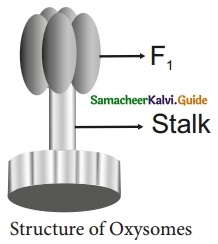
Question 4.
Name the three basic – tissues systems in flowering plants.
Answer:
The three basic tissue system in flowering plants are:
- Dermal or epidermal tissue system.
- Ground tissue system.
- Vascular tissue system.
Question 5.
What is photosynthesis and where in a cell does it occur?
Answer:
Photosynthesis is a process by which autotrophic organisms (green plants, algae and chlorophyll containing bacteria) utilize the energy from sunlight to synthesize their own food. It occur in the chloroplast of the cell.
Question 6.
What is respiratory quotient?
Answer:
Respiratory quotient is the ratio of volume of carbon dioxide liberated and the volume of oxygen consumed during respiration. It is expressed as
![]()
Question 7.
Why should the light – dependent reaction occur before the light-independent reaction?
Answer:
In light – dependent photosynthesis, the photosynthetic pigment absorbs the light energy and convert it into chemical energy, ATP and NADPH2. These products move out from grana to the stroma of the chloroplast for the light-independent reactions (Dark reaction or Biosynthetic pathway). During this reaction, CO2 is reduced in the carbohydrates with the help of light generated ATP and NADPH2. So the light-dependent reaction should occur before the light-independent reaction.
![]()
Question 8.
Write the reaction for photosynthesis.
Answer:
The overall reaction for photosynthesis.

VII. Long Answer Questions:
Question 1.
Differentiate the following:
(a) Monocot root and Dicot root
Answer:

(b) Aerobic and Anaerobic respiration
Answer:
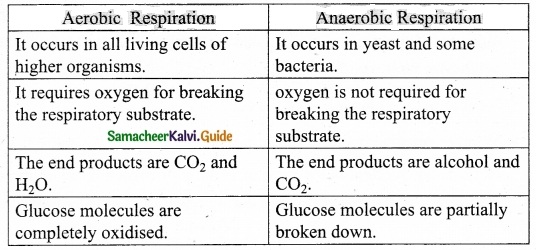
Question 2.
Describe and name three stages of cellular respiration that aerobic organisms use to obtain energy from glucose.
Answer:
The name and the three stages of cellular respiration.
- Glycolysis: (Glucose splitting): Glycolysis is the break down of one molecule of Glucose (6 Carbon) into two molecules of Pyruvic acid (3 Carbon). It takes place in the cytoplasm of the cell.
- Kreb’s cycle: This cycle occurs in the mitochondria matrix. At the end of Glycolysis, 2 molecules of pyruvic acid enter into mitochondria. The oxidation of pyruvic acid into CO2 and H2O takes place through this cycle. It is also called as Tricarboxylic Acid Cycle. (TCA)
- Electron transport chain: It is a system of Electron Transport Chain (ETC) located on the inner membrane of the mitochondria. NADH2 and FADH2 molecules formed during Glycolysis and Krebs cycle are oxidised to NAD+ and FAD+ to release the energy via electrons.
The electrons, as they move through the system, release energy which is trapped by ADP to synthesize ATP. This is called Oxidative Phosphorylation. During this process, oxygen which is the acceptor of electrons gets reduced to water.
Question 3.
How does the light dependent reaction differ from the light independent reaction?
What are the end product and reactants in each? Where does each reaction occur within the chioroplast?
Answer:
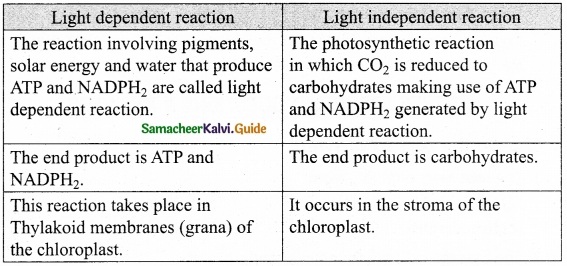
VIII. Higher Order Thinking Skills(HOTS):
Question 1.
The reactions of photosynthesis make up a biochemical pathway.
(a) What are the reactants and products for both light and dark reactions.
Answer:
The reaction of photosynthesis can be grouped into two: Light and Dark reaction.
The reaction involving pigments, solar energy and water that produce ATP and NADPH2 are called light reaction.
The photosynthetic reactions in which CO2 is reduced to carbohydrates making use of ATP and NADPH2 generated by light reaction are called dark reaction.
The overall reaction of photosynthesis can be written as follows:
![]()
(b) Explain how the biochemical pathway of photosynthesis recycles many of its own reactions and identify the recycled reactants.
Answer:
Light reaction use light to synthesize ATP and NADPH2. The calvin cycle uses these reactants to produce sugar from CO2 molecule.
This cycle then produce NAP + ADP + Pi which is used in light reaction with H2O molecules to produce ATP and NADPH2 again.
![]()
Question 2.
Where do the light-dependent reaction and the Calvin cycle occur in the chloroplast?
Answer:
The Light-dependent reaction occurs in the Thylakoid membranes (Grana) of the chloroplast. The Light independent reaction occurs in the stroma of the chloroplast.
Samacheer Kalvi 10th Science Plant Anatomy and Plant Physiology Additional Important Questions and Answers
I. Choose the correct answer:
Question 1.
The root hairs originate from:
(a) trichoblast
(b) endodermis
(c) hypodermis
(d) pericycle
Answer:
(a) trichoblast
Question 2.
Sachs classified tissue system in plants into _____.
(a) five types
(b) two types
(c) three types
(d) four types.
Answer:
(c) three types
Question 3.
The innermost layer of the cortex is:
(a) epidermis
(b) hypodermis
(c) endodermis
(d) pericycle
Answer:
(c) endodermis
Question 4.
The powerhouse of the cell or ATP factory of the cells _____.
(a) Plastids
(b) Vacuoles
(c) Nucleus
(d) Mitochondria.
Answer:
(d) Mitochondria.
Question 5.
The vascular bundle with protoxylem facing centre of the stem is:
(a) exarch
(b) endarch
(c) tetrarch
(d) polyarch
Answer:
(b) endarch
![]()
Question 6.
This is the first step of both Aerobic and Anaerobic respiration _____.
(a) Electron transport chain
(b) Respiratory Quotient
(c) Glycolysis
(d) Kreb’s Cycle.
Answer:
(c) Glycolysis
Question 7.
The vascular bundle in the leaf is:
(a) collateral and open
(b) collateral and closed
(c) bicollateral and open
(d) collateral and exarch
Answer:
(b) collateral and closed
Question 8.
Photosynthesis takes place in:
(a) mitochondria
(b) peroxisomes
(c) chloroplast
(d) ribosomes
Answer:
(c) chloroplast
Question 9.
The dark reaction of photosynthesis were discovered by:
(a) Embden and Meyer
(b) Melvin and Calvin
(c) Kreb
(d) Pamas
Answer:
(b) Melvin and Calvin
Question 10.
………. is the organelle of cell respiration.
(a) mitochondria
(b) chloroplast
(c) plastids
(d) cell wall
Answer:
(a) mitochondria
Question 11.
The hypodermis of monocot stem consists of:
(a) Collenchyma
(b) Sclsrenchyma
(c) Angular collenchyma
(d) Parenchyma
Answer:
(b) Sclsrenchyma
Question 12.
The layer is morphologically homologous to the endodermis found in the root which is:.
(a) periderm
(b) epidermis
(c) starch sheath
(d) mesophyll tissue
Answer:
(c) starch sheath
Question 13.
Pericycle is absent in:
(a) dicot stem
(b) monocot root
(c) dicot root
(d) monocot stem
Answer:
(d) monocot stem
Question 14.
………. is not a characteristic feature of spongy parenchyma.
(a) Gaseous exchange
(b) Photosynthesis
(c) Irregular
(d) Closely arranged
Answer:
(d) Closely arranged
Question 15.
Which of the following is not applicable of dicot stem?
(a) wedge shaped
(b) endarch
(c) collateral
(d) closed
Answer:
(d) Closely arranged
![]()
II. Application based question:
Question 1.
In the given flow chart different layer of monocot root is shown. What is A and B?

(a) A – Hypodermis, B – Vascular bundle
(b) A – Cortex, B – Vascular bundle
(c) A – Cortex, B – Xylem
(d) A – Hypodermis, B – Xylem
Answer:
(b) A – Cortex, B – Vascular bundle
Question 2.
Casparian strip are characteristic feature of A endodermis and it is made up of B. What is A and B respectively?
(a) shoot, suberin
(b) root, lignin
(c) root, suberin
(d) root and shoot, suberin
Answer:
(c) root, suberin
Question 3.
Which of the following is present in monocot leaves?
A. Bulliform cell
B. Leaf base
C. Bundle sheath
D. Resin gland
E. Water cavity
(a) A, B, C, E
(b) A, B, D, E
(c) A, B, E
(d) A, B, C
Answer:
(d) A, B, C
Question 4.
A vascular bundle in which phloem is on both the sides of the xylem and separated from it by strips of cambium is said to be:
(a) Collateral open
(b) Bicollateral open
(c) Concentric
(d) Bicollateral closed
Answer:
(b) Bicollateral open
Question 5.
Presence of cuticle is a common character of:
A. Monocot stem
B. Dicot stem
C. Monocot root
D. Dicot root
E. Monocot leaf
F. Dicot leaf
(a) A, B, E, F
(b) B, F
(c) A, B, C, D, E, F
(d) A, E, F
Answer:
(a) A, B, E, F
III. Fill in the blanks:
1. ………. is known as “Father of Plant Anatomy”.
2. ……….. are the group of cells that are similar or dissimilar in structure and origin, but perform similar function.
3. Based on the ability to divide, tissues are classified into ……….. and ……… tissue.
4. ………. is the outermost layer.
5. The main function of vascular tissue system are transport of ……….. and ……….
6. Epidermis protects the ……… tissue.
7. ………, ………., ………… and ……….. forms the ground tissue system.
8. Epiblema is also known as ……… or ……….
9. ……….. helps in the movement of water and dissolved salts from cortex into xylem.
10. The tissue present between xylem and phloem is called …………
11. All the tissues inner to endodermis constitute …………
12. The tissue present between the upper and lower epidermis is called …………
13. Reaction centres and the accessory pigments together are called …………
14. Light reaction takes place in ………. membrane of the chloroplast.
15. Kreb cycle is also known as ……….
16. Glycolysis take place in ……… of the cell.
17. Krebs cycle occurs in ……….. matrix.
18. The gas evolved during photosynthesis is ……….
19. The first step in aerobic respiration is ………..
20. Energy currency of cells is ………..
21. Major functions of epiblema is ……….
Answer:
1. Nehemiah Grew
2. Tissues
3. Meristamatic and Permanent
4. Epidermis
5. Water and Food
6. inner
7. Cortex, Endodermis, Pericycle and Pith
8. Rhizodermis or Piliferous layer
9. Casparian strips
10. Conjuctive tissue
11. Stele
12. Hypodermis
13. Photosystems
14. thylakoid
15. Tricarboxylic Acid Cycle (TCA)
16. Cytoplasm
17. Mitochondria
18. Oxygen
19. Glycolysis
20. ATP
21. Protection
![]()
IV. Match the following:
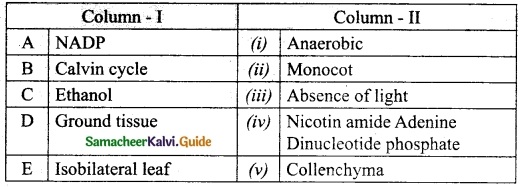
Answer:
A. (iv)
B. (iii)
C. (i)
D. (v)
E. (ii)
V. Answer in Sentence:
Question 1.
What are the functions of Epidermis?
Answer:
- The epidermis protects the inner surface.
- Stomata help in transpiration.
- Root hairs help in absorption of water and minerals.
Question 2.
Name the factors which affect photosynthesis.
Answer:
The process of photosynthesis is affected internally by:
- Pigments
- Leaf age
- Accumulation of carbohydrates and
- Hormones.
The process of photosynthesis is affected externally by:
- Light
- CO2
- Temperature
- Water
- Minerals.
Question 3.
What are Oxysomes?
Answer:
The inner mitochondria membrane bear minute regularly spaced, Tennis racket shaped particles called Oxysomes, which involve in ATP synthesis.
Question 4.
What is Cortex?
Answer:
The region below the epidermis is called cortex. Its main function is to store starch.
Question 5.
What is Pericycle?
Answer:
Pericycle is the outer most layer of stele. It is made of single layer of thin walled cells.
Question 6.
What are the functions of chloroplasts?
Answer:
- Photosynthesis
- Storage of starch
- Synthesis of fatty acids
- Storage of lipids
- Formation of chloroplasts.
Question 7.
Where are passage cell located and write its function?
Answer:
The passage cell is an endodermal cell located opposite to the protoxylem, which are thin wall without casparian strips. The main function of passage cell is entry of water from cortex to xylem.
Question 8.
What is protoxylem lacuna?
Answer:
In mature vascular bundle the lowest proto xylem disintegrates and form a cavity called protoxylem lacuna. Eg: Monocot stem.
![]()
Question 9.
Define Kreb’s cycle.
Answer:
The series of cyclic reaction involved in converting pyruvic acid to CO2 and water in mitochondria is called Kreb’s cycle.
Question 10.
Why mitochondria is called ‘Power house of the cell’?
Answer:
A large number of ATP molecules are produced in the mitochondria, so they are called power house of the cell.
VI. Short answer questions:
Question 1.
Name the three types of plastids.
Answer:
- Chloroplast: green coloured plastids helps in photosynthesis.
- Chromoplast: yellow, red, orange coloured plastids, gives colour to flowers and fruits.
- Leucoplast: colourless plastids, store food.
Question 2.
List out the functions of chloroplast.
Answer:
- Photosynthesis
- Storage of starch
- Synthesis of fatty acids
- Storage of lipids
Question 3.
What are Concentric bundles? Explain its types.
Answer:
Vascular bundles in which either xylem completely surrounds the phloem or phloem surrounds the xylem is called concentric vascular bundle. It is of two types:
- Amphivasal: Xylem surrounds phloem. Eg: Dracaena
- Amphicribral: Phloem surrounds xylem. Eg: Ferns
Question 4.
What are photosynthetic pigment?
Answer:
- Pigments involved in photosynthesis are called Photosynthetic pigments.
- Primary pigment traps solar energy and converts it into electrical and chemical energy. Accessory pigments pass on the absorbed energy to primary pigment.
Question 5.
(a) Differentiate between Palisade parenchyma and spongy parenchyma.
Answer:
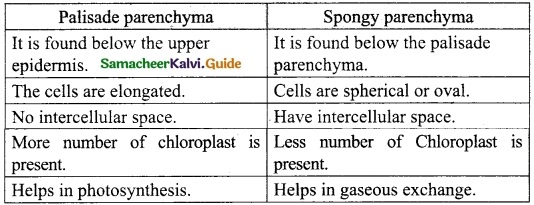
(b) Differentiate between Monocot ieaf and Dicot leaf.
Answer:
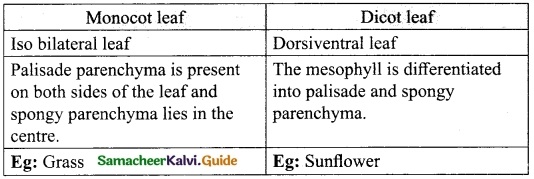
Question 6.
Define stele.
Answer:
Central Part inner to endodermis is called stele. It includes pericycle and vascular system.
Question 7.
Where respiratory cavity is located?
Answer:
The air space that is found next to the stomata is called respiratory cavity or sub stomatal cavity.
![]()
Question 8.
What is an isobilateral leaf? Give an example.
Answer:
In monocot leaf, the mesophyll is not differentiated into palisade parenchyma and spongy parenchyma (i.e., made of only spongy or palisade parenchyma) is called isobilateral leaf.
Eg: Grass (Monocot leaf)
Question 9.
What is dorsiventral leaf? Give an example.
Answer:
In dicot leaf, the mesophyll is differentiated into palisade parenchyma on the upper side and spongy parenchyma on the lower side. A leaf showing this differentiation is mesophyll is designated as dorsiventral. Eg: Dicot leaf.
Question 10.
Define tetrarch xylem.
Answer:
If the number of proto xylem points are four, the xylem is called tetrarch. Eg: Dicot root
Question 11.
What are generally called as accessory pigments?
Answer:
Photosynthetic pigments other than chlorophyll ‘a’ are generally I called accessory pigments. Eg: Chlorophyll ‘A’- Carotenoids and Xanthophyll.
Question 12.
W’rite any three significance of photosynthesis.
Answer:
- It is the source of all our food and fuel,
- It drives all other process of biological and a biological world,
- It is responsible for the growth and sustenance of our biosphere.
Question 13.
What are the functions of epidermal tissue system?
Answer:
- Epidermis protects the inner tissues.
- Stomata helps in transpiration.
- Root hairs help in absorption of water and minerals.
Question 14.
Differentiate between monocot and dicot stem.
Answer:
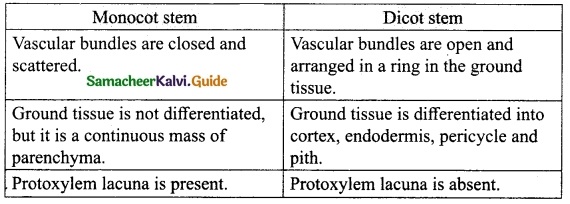
VII. Long answer questions:
Question 1.
Explain Epidermal tissue system.
Answer:
- The outer most covering layer of plants.
- It contains epidermis, stomata and epidermal out growths.
- Epidermis are interrupted by many minute pores called stomata.
- Epidermis is covered by cuticle to check evaporation of water.
- Trichomes and root hairs are some epidermal growths.
![]()
Question 2.
Explain the types of Vascular bundle.
Answer:
Xylem and Phloem are present in the form of bundles called vascular bundles.
1. Radial
2. Conjoint
3. Concentric.
1. Radial vascular bundle : Xylem and phloem are arranged in an alternate matter or different radii are called Radial vascular bundle. Eg: roots
2. Conjoint vascular bundle : Xylem and phloem are arranged in the same radius are called conjoint vascular bundle. Divided in two types:
(a) Collateral vascular bundles : Xylem and phloem are arranged in the same radius with phloem towards the outside is called collateral vascular bundles. Eg: stem and leaf.
Collateral vascular bundles are of two types:
- Open collateral vascular bundle: Vascular bundle consists of cambial tissue in between xylem and phloem are called Open collateral vascular bundle. Eg: Dicot stem
- Closed collateral vascular bundle: Cambium is absent in vascular bundle are called Closed collateral vascular bundle. Eg: Monocot stem.
(b) Bicollateral : Phloem occurs on both the outer and inner side of xylem. This vascular bundle is Bicollateral vascular bundle. Eg: Cucurbita.
3. Concentric vascular bundle : The vascular bundle in which either phloem surrounds the xylem or xylem surrounds the phloem completely called Concentric vascular bundles. It is of two types: (a) Amphivasal, (b) Amphicribral.
(a) Amphivasal: The Xylem completely surrounds the phloem. Eg: Dracaena
(b) Amphicribral: The Phloem completely surrounds the xylem. Eg: Ferns
Exarch: Protoxylem vessels are present towards the periphery and meta xylem towards the centre. Eg: Root
Endarch: Protoxylem are present towards the centre and meta xylem towards the periphery. Eg: Stem
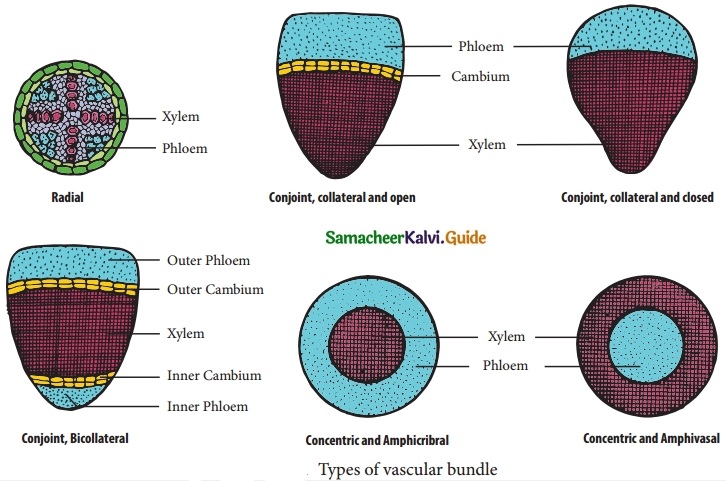
Question 3.
Explain the Primary structure of Monocot root.
Answer:
The internal structure of Monocot root has
1. Epiblema/Rhizodermis
2. Cortex
3. Endodermis
4. Stele
1. Epiblema/Rhizodermis:
- Outer most layer of monocot root.
- Made up of single layer of thin walled, paranchymatous cell.
- Root hair helps in absorption of water and minerals.
- Stomata and cuticle are absent.
- Main function is to protect inner tissue.
2. Cortex:
- The region below the epidermis is cortex.
- Made up of only parenchymatous cells with intercellular space.
- It is a multi layer.
- Function is to store water and food material.
3. Endodermis:
- Inner most cortex is called Endodermis.
- It forms a complete ring around the stele with characteristic Casparian strips and Passage cell.
- There is a band like thickening made of suberin in casparian strips.
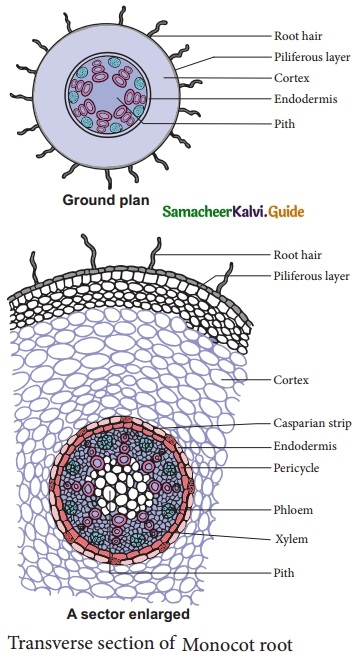
(iv) Stele:
Central part inner to endodermis is stele.
It contains Pericycle, vascular bundles and pith.
(a) Pericycle:
- Outer most layer of stele made of single layer of tightly arranged Parenchymatous cell.
- Function is to originate lateral root.
(b) Vascular bundles:
- Radial arrangement of vascular tissue.
- Xylem is exarch and polyarch.
- The conjuctive tissue is sclerenchymatous tissue.
(c) Pith:
- Large central part, composed of parenchyma cells with intercellular spaces.
- Function is to store the starch.
Question 4.
Draw the structure of Dicot root.
Answer:
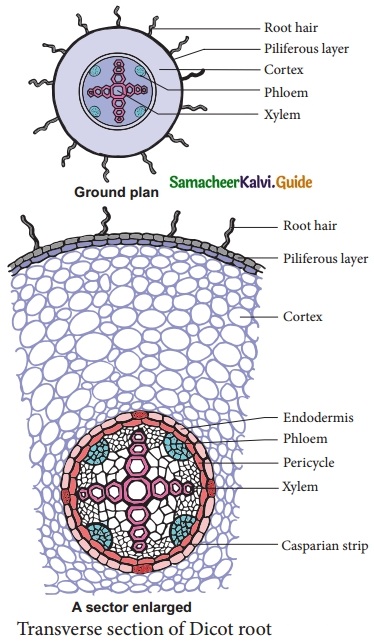
Question 5.
Describe the Primary structure of T.S of Monocot stem.
Answer:
(i) Epidermis:
- Outer most layer of monocot stem.
- Made up of single layer and tightly packed parenchyma cells.
- Outer wall is covered by thick cuticle.
- Few stomata are seen in epidermis.
- Multicellular hairs are absent.
(ii) Hvpodermis:
- The layer below the epidermis is called hypodermis.
- Hypodermis is made up of sclerenchymatous cells.
- It is interrupted by chlorenchyma.
Sclerenchyma provides mechanical support to plant.
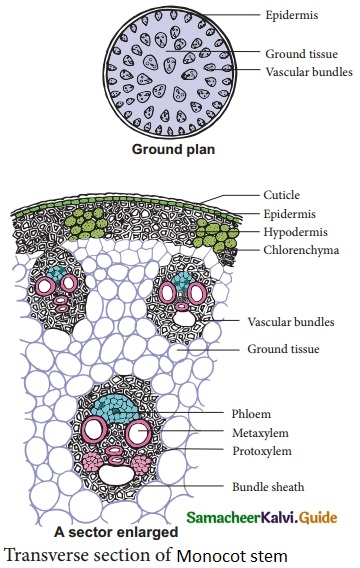
(iii) Ground tissue:
- There is no distinction of cortex, endodermis, pericycle and pith.
- Inner to hypodermis parenchyma cell forms the ground tissue.
(iv) Vascular bundles:
- Vascular bundles are scattered in the ground tissue. Each vascular bundle are surrounded by bundle sheath by sclerenchymatous tissue.
- Vascular bundles are conjoint, collateral, endarch and closed.
- Xylem contains meta xylem and protoxylem.
- In mature Vascular bundle the lowest protoxylem disintegrates and form a cavity called protoxylem lacuna.
- Phloem contains seive tubes and companion cells.
(v) Pith:
- It is not differentiated in monocot stem.
![]()
Question 6.
Write a short note on structure of chloroplast.
Answer:
(i) Chloroplast are the actual site of photosynthesis.
(ii) They are green plastids containing green pigment called chlorophyll.
(iii) It mainly consists of Envelope, Stroma, Thylakoids and Grana.
Envelope : Chloroplast has outer and inner envelope membranes which is seperated by intermembrane space.
Stroma : Matrix present inside to the membrane is called stroma. It contains DNA, 70 S ribosomes and other molecules required for protein synthesis.
Thylakoids : It’s membrane encloses thylakoid lumen. Thylakoids forms a stack of disc like structures called a grana (singular-granum).
Grana : Some of the thylakoids are arranged in the form of discs stacked one above the other. These stacks are termed as grana,they are interconnected to each other by membranous lamellae called Fret channels.
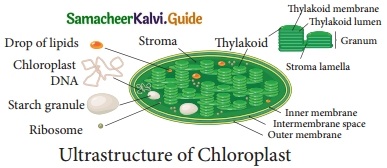
Question 7.
Explain the primary structure of T.S Dicot stem.
Answer:
The internal structure of Dicot stem has
(i) Epidermis :
- Outer most layer of dicot stem made up of tightly packed parenchyma cells.
- Outer wall is covered by thick cuticle which check transpiration.
- Few stomata and multicellular hairs are present in epidermal cells.
(ii) Cortex :
Cortex is differentiated into 3 zones:
- Hypodermis : The layer below the epidermis is called Hypodermis. It is made by few layers of collenchymatous cells which gives mechanical strength.
- Middle cortex : Inner to hypodermis is made up of few layer of chlorenchymatous tissue which helps in photosynthesis.
- Inner cortex : Inner cortex is made by parenchyma cells which stores food materials. The inner most layer of cortex is called endodermis. The cells are compactly arranged in barrel shaped cells that contain starch grains. So this layer also called starch sheath.
(iii) Stele :
Central part inner to endodermis is called stele. It contains pericycle, vascular bundle and pith.
- Pericycle : A few layer of sclerenchyma cells occurs in patches outside the phloem in each vascular bundle.
- Vascular bundle : Vascular bundle are conjoint collateral, endarch and open. They are arranged in the form of ring.
- Pith : Large central part, composed if parenchyma cells with intercellular spaces. Function is to store the food.
Question 8.
Describe the structure of T.S of dicot leaf.
Answer:
The T.S of dicot leaf contains
(i) Epidermis – Upper and Lower
(ii) Mesophyll
(iii) Vascular bundles
(i) Epidermis :
The leaf is dorsiventral it has upper and lower epidermis.
- Upper Epidermis : Made up of single layer of tightly packed parenchyma cells. Cuticle is thicker than the lower epidermis.
- Lower Epidermis : Made up of single layer of parenchymatous cells with thin cuticle. Stomata are more in Lower epidermis. Used for transpiration and gaseous exchange.
(ii) Mesophyll :
The region between upper and lower epidermis is called mesophyll. It is differentiated into palisade and spongy parenchyma.
- Palisade parenchyma: Present below the upper epidermis cells are elongated. Cells do not have intercellular spaces. More number of chloroplast present. Function is photosynthesis.
- Spongy parenchyma: Present above the lower epidermis. Cells are irregular shaped. Cells have intercellular spaces less number of chloroplast is present. Function is gaseous exchange.
(iii) Vascular bundles : Vascular bundles are conjoint, collateral and closed. Vascular bundles are surrounded by a compact layer of parenchymatous cells. These are called Bundle sheath. Xylem is present towards the upper epidermis. Phloem is present towards the lower epidermis.
VIII. Higher Order Thinking Skills (HOT).
Question 1.
The cells of endodermis show band like thickening on their radial and inner tangential walls called casparian strips. Why?
Answer:
It is to prevent the re-entry of water into the cortex once water entered the xylem tissue.
Question 2.
Do plants like Croton, with non – green leaves have chlorophyll and do they perform photosynthesis?
Answer:
The chlorophyll is present in Croton leaves, embedded along with other coloured pigments like carotenoids and anthocyanin. These coloured pigments assist or help the pigment chlorophyll in the process of photosynthesis.
![]()
Question 3.
How do we see beautiful colours in Autumn and enjoy the fall?
Answer:
Chlorophyll gives a green colour to plants. During winter, there is not enough light for photosynthesis. So they use food, which is stored in summer. As the green chlorophyll disappears or fades away, we begin to see yellow, orange and red colour. We cannot see them in summer, because they are covered by the green chlorophyll.
But in autumn or fall season glucose trapped in the leaves, after photosynthesis stops. Sunlight and cool nights of autumn cause the leaves to turn this glucose into a red colour.
It is the combination of all these things, that make the beautiful colours, we enjoy in the fall.